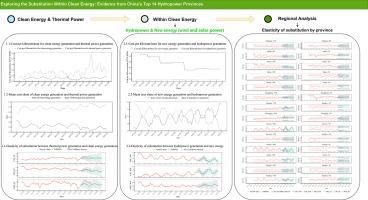Exploring the substitution within clean energy: Evidence from China's top 14 hydropower provinces
引用次数: 0
Abstract
This paper quantitatively examines the substitution effects within China's clean energy sector, focusing on the hydropower and new energy generation sectors across the top 14 hydropower-producing provinces, which collectively contribute to over 80 % of the country's total hydropower output. To provide a comprehensive analysis of regions that significantly influence national trends, the study utilizes the Cross-Price Elasticity (CPE) and Morishima Elasticity of Substitution (MES). CPE measures how the quantity demanded of one energy source responds to a change in the price of another, while MES assesses the sensitivity of the ratio between two energy inputs to price changes. A Seasonal Autoregressive Integrated Moving Average (SARIMA) model is employed to forecast energy substitution dynamics, offering robust predictive accuracy. The average MES between clean energy and thermal power is 0.663, indicating a moderate substitution relationship, with the effect more pronounced in summer. Additionally, the mean MES between hydropower and new energy generation is 2.067, reflecting a strong substitution effect between these two clean energy forms. Furthermore, the SARIMA model shows a mean squared error (MSE) as low as 0.0006 in some cases, demonstrating its robust predictive accuracy in forecasting energy substitution dynamics. These results offer empirical support for policies aimed at reducing reliance on thermal power and promoting clean energy development in key provinces.

探索清洁能源的替代性:来自中国 14 个水电大省的证据
本文定量研究了中国清洁能源行业的替代效应,重点关注水电产量最高的 14 个省份的水电和新能源发电行业,这 14 个省份的水电产量合计占全国水电总产量的 80% 以上。为了全面分析对全国趋势有重大影响的地区,研究采用了交叉价格弹性 (CPE) 和森岛替代弹性 (MES)。CPE 衡量一种能源的需求量如何对另一种能源的价格变化做出反应,而 MES 则评估两种能源投入之间的比率对价格变化的敏感性。采用季节自回归综合移动平均(SARIMA)模型来预测能源替代动态,具有很高的预测准确性。清洁能源与火力发电之间的平均 MES 为 0.663,表明两者之间存在适度的替代关系,夏季的替代效应更为明显。此外,水力发电与新能源发电之间的平均 MES 为 2.067,反映出这两种清洁能源形式之间存在较强的替代效应。此外,SARIMA 模型在某些情况下的均方误差(MSE)低至 0.0006,这表明该模型在预测能源替代动态方面具有很强的预测准确性。这些结果为重点省份减少对火电的依赖、促进清洁能源发展的政策提供了经验支持。
本文章由计算机程序翻译,如有差异,请以英文原文为准。
求助全文
约1分钟内获得全文
求助全文

 求助内容:
求助内容: 应助结果提醒方式:
应助结果提醒方式:


